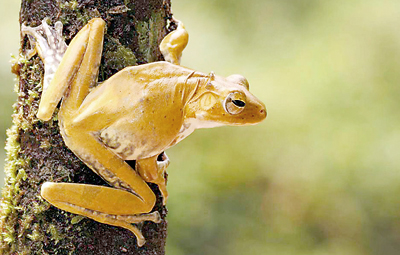News
A tree frog leaps into list of Endemic Amphibians
Researchers worry that the only known population of new endemic tree frogs Polypedates ranwellai, named in honour of Dr. Sanjeewa Ranwella, could soon become extinct.
Sri Lanka, already known as an Amphibian hotspot, reveals another new frog at the Gilimale Forest of Peak Wilderness. Leading researcher Mendis Wickramasinghe of the Herpetological Foundation of Sri Lanka, who, together with the late Dr. Amith Munindadasa and Dr. Prithviraj Fernando, published a scientific paper in a world’s leading journal, recently updated Sri Lanka’s Amphibians to 112.
The new frog has been named Polypedates ranwellai or Ranwella’s spined tree frog. Mr Wickramasinghe said the frog was named after the late Dr. Sanjeewa Ranwella in honour of his exceptional dedication towards wildlife conservation in Sri Lanka. Dr Ranwella was an active member and an instructor at the Young Zoologists’ Association (YZA) who met with an untimely death at a young age in a boat accident in 2003. Dr. Ranwella and Mr Wickramasinghe were colleagues at YZA and had conducted many field excursions together. Mr Mendis said the new species had been first observed in 2000 during a field visit to the Gilimale forest reserve with Dr. Ranwella. The research team later collected specimens and subjected them to a rigorous scientific process to establish that the species is unique and endemic to Sri Lanka.

Although the new species tentatively categorised under the genus Polypedates, the researchers pointed out that this species shows extreme deviations, especially in the skull, from other specimens of the same group, indicating that the new frog could belong to a new genus. Its specialty is the 6 spines located on the sides of its jaws and on the parietal area on the back of the head. Mr Wickramasinghe said that tree frogs with these kinds of spines were found in Brazil and Ghana. The female of this species is about 6 cm, so it is a comparatively large frog.
However, the habitat of this endemic frog is already threatened. Forest fragmentation has become the major threat in this area due to accelerated deforestation. The Induruwa mukalana and Guruluwana regions have become separated by deforestation in the past 10 years, and are now two separate islands according to Mr Mendis. Researchers point out that the many pot holes in its gravel road, which filled with water during the monsoons and served as breeding grounds for these species, has now been concreted, while the existing pot holes quickly run dry when vehicle go over them. Concreting of the road attracts more visitors, and hence more vehicles visit the forest reserve, and consequently, large amounts of garbage is being left behind in the forest.
Apart from logging and encroachment by tea plantations, hazardous activities such as gem mining, sand mining, use of agro chemicals, cutting down and setting fires in the forest edge are also posing threats. All these continued harmful anthropogenic activities consequently, pose other harmful effects such as drying out of water bodies and soil erosion.
Researchers also worry that the proposed construction of a dam across the Kalu Ganga will flood a large area including the Gilimale reserve, completely wiping out the only known population of Polypedates ranwellai from the island – hence a loss to the whole world.
Mr Mendis also dedicates this research paper to the memory of Dr. Amith Munindradasa, one of the co-authors of the publication, whose untimely death was a great loss to the country. An electronic engineer by profession, Dr. Munindradasa was a man of many talents. He had discovered many species new to science, and worked together with the research team till his death.
International meeting on Biodiversity opens in Hyderabad India
Representatives from over 170 countries including Sri Lanka, meet in Hyderabad, India, this week, to discuss the way forward to protect the earth’s biodiversity. This meeting – 11th Conference of Parties of United Nation’s Convention of Biological Diversity will focus on adopting a new Strategic Plan to halt biodiversity loss by the end of this decade.
Meanwhile, the International Union on Conservation of Nature (IUCN), including experts on biodiversity too, has held its congress in South Korea. Scientists highlight that the rate of species extinction has doubled and that, many known species as well as species new to science, will soon become extinct, if the current level of threats continue. Their decline have been mainly caused by humans, but, in almost all cases, scientists believe their extinction can still be avoided, if conservation efforts are specifically focused. They also point out that species extinction will even indirectly affect humans.
Follow @timesonlinelk
comments powered by Disqus






















